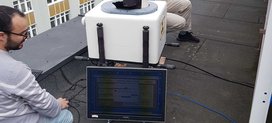
PURER-EXP campaign 12.06 - 3.07.2023 in the frame of the PURER-SENS project
The experimental campaign PURER-EXP is being performed in the frame of the PURER-SENS project led by Pablo Ortiz-Amezcua. Together with the team members, Iwona S. Stachlewska, Łucja Janicka, Marta Wacławczyk, Maciej Karasewicz, and with the support of Wojciech Kumala, collocated and synchronous measurements of wind and aerosols have been performed with Doppler lidar and Raman lidar since October 2022 at the Remote Sensing Laboratory (RS-Lab) Warsaw station located at the Faculty of Physics (FUW), University of Warsaw. One of the main goals of the campaign is to measure particle fluxes over the Warsaw urban environment, i.e., the exchange of aerosol particles from the surface to the lower atmosphere and how this exchange is behaving under different conditions. Next, the calculated exchanges will be compared with other urban locations from Northern as well as Southern Europe, where different meteorological conditions are predominant. This research is being done with intensive Polish-Finish-Spanish cooperation.
The lidar technique - light detection and ranging - has become in the last decades one of the most efficient for atmospheric studies, due to its huge potential. Its main strength is the possibility of routine measurements with high vertical and temporal resolution. The unique Raman-polarization-watervapour PollyNeXT Lidar at the RS-Lab will provide information on the distribution of aerosols in the atmosphere, including the characterization of their properties. This system measures continuously the aerosol optical properties in 12 channels and can be used to derive the amount of aerosol, the size, and shape of aerosol particles, as well as the height and thickness of the formed aerosol layers. RS-Lab Doppler wind lidar HALO consists of a solid-state pulsed laser emitting infrared radiation and a heterodyne detector using fiber-optic technology, which is able to detect the frequency change in the received radiation due to the movement of the aerosol particles with the wind. The signal acquisition is performed continuously and autonomously in vertical mode with an adjustable temporal resolution down to 0.1 s and range resolution down to 18 m, and it also has full hemispheric scanning capability. With this system, it is possible to obtain vertical profiles of 3-Dimensional wind vectors at different altitudes within the whole atmospheric boundary layer.
The last stage of the campaign, which was already started on 12 June and will last until 3 July 2023, has involved the participation of the Atmospheric Physics Group from the University of Granada. The Spanish institution contributed with a similar Doppler lidar system that has been installed at the Institute of Fundamental Technological Research Polish Academy of Sciences (IPPT PAN) roof, around 500 m apart from the Faculty of Physics, University of Warsaw. Visiting scientist and Doppler lidar expert Prof. Ewan O'Connor from Finnish Meteorological Institute was also participating in the design and set up of the campaign. This exceptional dual-Doppler lidar setting will allow us to measure and compare winds, turbulence, and particle fluxes at two points in the city and in the horizontal area surrounding the stations. These measurements will be used to investigate and validate the recent theories about turbulence scaling and structures in the atmospheric boundary layer.
Originally published on - June 21, 2023, 8 a.m.
Last update on - June 26, 2023, 11:38 a.m.
Publisher - Dąbrówka Stępniewska
PHOTO GALLERY

